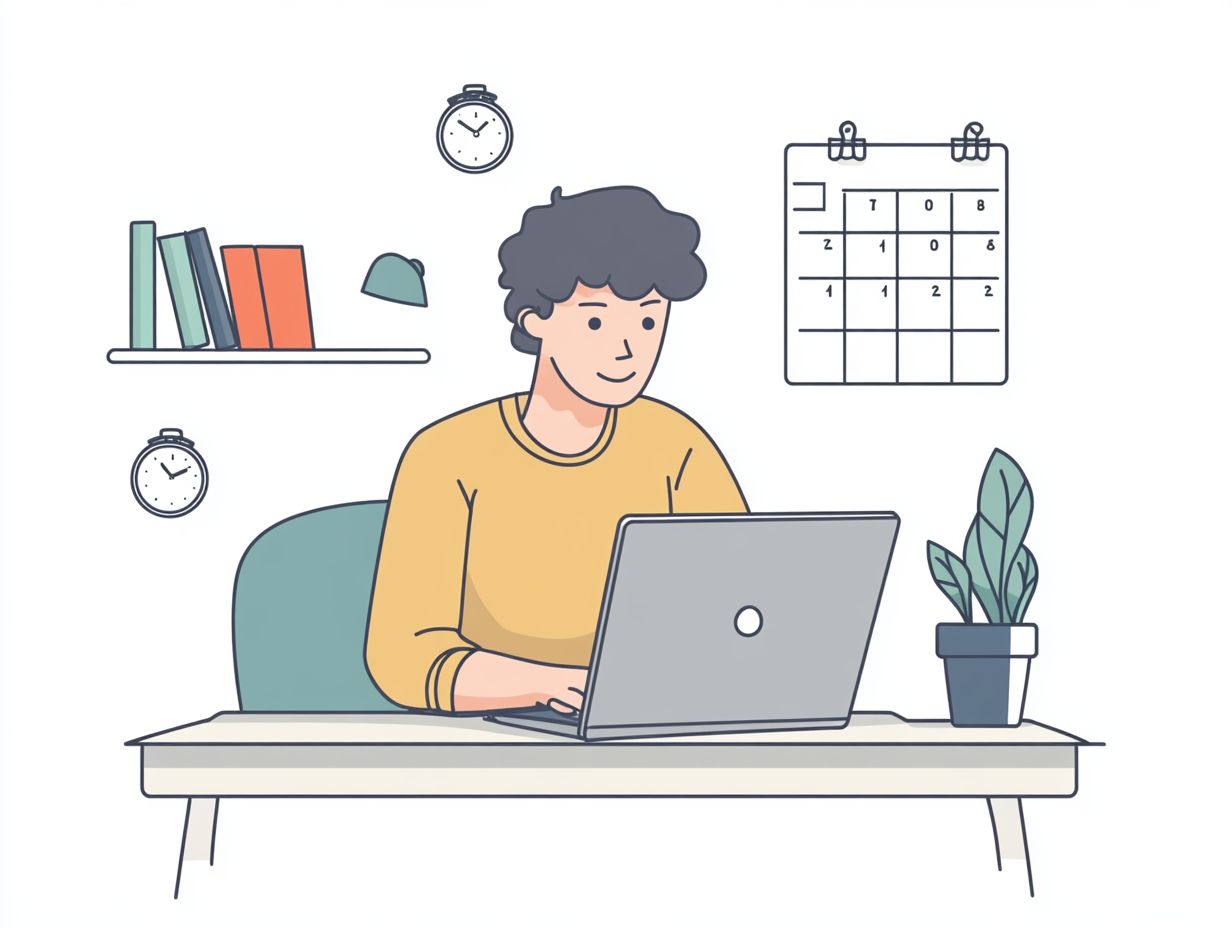10 Practical Exercises to Reduce Procrastination
Procrastination often resembles an endless loop, stifling productivity and amplifying stress. Don t let procrastination hold you back any longer! Start implementing these strategies today! If you ve ever found yourself sidestepping crucial tasks, rest assured, you re not in this alone.
This article presents 10 practical exercises crafted to help you liberate yourself from procrastination and reclaim authority over your time. Ranging from the art of crafting effective to-do lists to designing a distraction-free workspace, these strategies are designed to elevate your focus and motivation.
Explore these insights to uncover how you can transform your habits and significantly enhance your productivity!
Contents
- Key Takeaways:
- 1. Make a To-Do List and Prioritize Tasks
- 2. Break Down Tasks into Smaller, Manageable Chunks
- 3. Set Realistic Goals and Deadlines
- 4. Create a Productive Workspace
- 5. Eliminate Distractions
- 6. Use the Pomodoro Technique
- 7. Reward Yourself for Completing Tasks
- 8. Practice Mindfulness and Focus Techniques
- 9. Get an Accountability Partner
- 10. Reflect on the Consequences of Procrastination
- How Can Procrastination Affect Your Mental Health?
- Frequently Asked Questions
- 1. What are some exercises to reduce procrastination?
- 2. How can creating a to-do list help reduce procrastination?
- 3. Why is setting specific goals and deadlines important in reducing procrastination?
- 4. How can practicing mindfulness be an effective exercise for reducing procrastination?
- 5. What role does accountability play in reducing procrastination?
- 6. How can creating a supportive environment help in reducing procrastination?
Key Takeaways:

- Create a to-do list and prioritize tasks to stay organized and focused.
- Break tasks into smaller chunks to make them manageable.
- Set realistic goals and deadlines to stay accountable.
1. Make a To-Do List and Prioritize Tasks
Creating a to-do list and prioritizing your tasks is a key strategy that can effectively combat procrastination, enhance your productivity, and sharpen your time management skills.
This approach ultimately leads to successful task completion and boosts your self-confidence in your abilities. By outlining your goals and responsibilities clearly, you gain a visual representation of your daily objectives.
This transforms overwhelming projects into manageable steps. You ll feel great as you check off tasks and see your progress!
Consider utilizing frameworks like the Eisenhower Matrix, which is a way to sort your tasks based on what is urgent and important. This ensures that critical items are addressed promptly while minimizing the tendency to get bogged down by less significant activities.
Such organized planning is essential for counteracting failure to regulate oneself. It reinforces your discipline and motivation, paving the way for higher productivity levels and more effective use of your time.
2. Break Down Tasks into Smaller, Manageable Chunks
Breaking down tasks into smaller, manageable chunks is a powerful strategy for you to reduce task aversion, boost motivation, and combat procrastination. When daunting tasks are segmented, they become more achievable and less overwhelming.
This technique is similar to ideas from cognitive-behavioral therapy, which focuses on changing your thoughts and actions. For instance, if you’re facing a significant project at work, it s easy to feel paralyzed by its enormity. But by dividing it into subtasks like research, outlining, and drafting you can concentrate on completing one small piece at a time.
Implementing tactics such as setting specific time limits for each chunk or using a checklist to track your progress can further enhance your motivation. These techniques not only cultivate a sense of accomplishment but also build resilience against anxiety, enabling you to approach future challenges with newfound confidence.
3. Set Realistic Goals and Deadlines
Setting realistic goals and deadlines is essential in tackling procrastination. This strategy alleviates the pressure of perfectionism and has a positive impact on your self-esteem, all while helping you manage stress levels effectively.
By employing the SMART framework, you can carve out clear pathways to your achievements. This approach requires you to identify specific objectives that are measurable and attainable, ensuring that you can track your progress meaningfully.
When your goals align with your personal values and interests, they become more motivating and achievable, which is crucial for maintaining engagement. Establishing a definitive timeline not only encourages accountability but also instills a sense of urgency, driving your productivity.
Ultimately, by concentrating on realistic expectations, you enhance your performance and nurture your emotional well-being. This reduces the likelihood of burnout and promotes a more balanced lifestyle.
4. Create a Productive Workspace
Creating a productive workspace is crucial for minimizing distractions. It cultivates an environment that nurtures emotional intelligence, enhancing your ability to complete tasks effectively.
A well-organized space grants you easy access to the materials you need. This reduces the mental effort required to manage tasks and allows you to concentrate better on your work.
Consider how the right lighting can transform your mood and energy levels. A bright, airy workspace can feel invigorating, while dim lighting may leave you feeling sluggish.
Investing in ergonomic furniture is essential. It helps prevent discomfort that can sap your focus and motivation.
These elements create a harmonious atmosphere where creativity and efficiency flourish. This benefits both your mental well-being and overall productivity.
5. Eliminate Distractions
Eliminating distractions is a crucial step in your battle against procrastination. It nurtures a motivated mindset.
In your daily life, distractions can pop up from various sources technology, noise, and even your own wandering thoughts.
Take smartphone notifications, for example. They often vie for your attention, pulling you away from productive activities.
To counter these interruptions, establish dedicated work periods free from alerts. Create a serene environment or employ techniques like the Pomodoro Method. These strategies significantly enhance your concentration levels.
By implementing them, you cultivate an atmosphere that supports focus. This strengthens your coping mechanisms and leads to increased productivity and a profound sense of accomplishment.
6. Use the Pomodoro Technique

Utilizing the Pomodoro Technique is a highly effective method to elevate your productivity. It helps you master time management.
This approach encourages focused work sessions punctuated by short breaks. It serves as a powerful antidote to procrastination and catalyzes improved task completion rates.
Typically, you ll work in intervals of 25 minutes, known as “Pomodoros,” followed by a refreshing 5-minute break.
After completing four Pomodoros, it’s advisable to take a longer break of 15 to 30 minutes. This helps you recharge and reflect on your accomplishments.
This structured methodology keeps you focused and reduces fatigue. It makes your work sessions more enjoyable!
Numerous studies showcase its effectiveness. Individuals who embrace this technique often experience significant boosts in productivity levels.
Many have shared experiences of reduced anxiety, enhanced focus, and improved overall well-being. The Pomodoro Technique is invaluable for both students and professionals alike.
7. Reward Yourself for Completing Tasks
Rewarding yourself for completing tasks can be a powerful motivator. It effectively combats procrastination while enhancing your self-esteem through positive reinforcement.
This process fosters a sense of achievement. It encourages you to develop a habit loop, where your brain starts associating task completion with gratifying feelings.
Over time, you ll discover that rewarding yourself evolves from a simple incentive into a vital component of your routine.
By consistently nurturing this loop, you cultivate a stronger sense of confidence and an intensified drive for productivity.
Engaging in self-rewarding strategies transforms mundane tasks into valuable opportunities for growth and satisfaction.
This leads to improved time management and a deeper sense of personal fulfillment.
Start using these strategies now, and watch your productivity soar!
8. Practice Mindfulness and Focus Techniques
Practicing mindfulness and focus techniques can significantly reduce procrastination, and utilizing 10 techniques to help you stop procrastinating can enhance your emotional intelligence and help you manage distractions.
By engaging in various mindfulness practices, you can feel more present. This awareness allows you to spot the triggers that lead to overcoming procrastination.
Techniques like meditation, deep breathing exercises, and mindful observation help you recognize and manage feelings of anxiety or overwhelm.
These practices build resilience and promote emotional regulation. They empower you to stay focused on your tasks and minimize stress.
Over time, these techniques can greatly boost your emotional well-being, leading to a more productive and fulfilling lifestyle.
9. Get an Accountability Partner
Having an accountability partner can dramatically reduce procrastination. You’ll find the motivation and support to tackle your tasks while enjoying a vibrant social life.
When you share your goals with someone who understands you, it creates responsibility. This bond instills discipline and provides a supportive atmosphere.
Embracing social support systems boosts your motivation. To find the right partner, connect with friends, colleagues, or explore online communities focused on personal development.
Regular check-ins through calls, messages, or meetings can offer encouragement and help you stay focused.
10. Reflect on the Consequences of Procrastination
Reflecting on the effects of procrastination provides valuable insights. It can help you address emotional health issues and improve your self-esteem.
Consider a college student who delays assignments until the eleventh hour. This may harm academic performance and increase anxiety.
If not addressed, this cycle can damage self-confidence and create a loop where fear of failure worsens delays. Similar patterns occur in workplaces, affecting stress and job satisfaction.
The long-term effects of procrastination extend beyond productivity; they impact mental health and overall quality of life.
How Can Procrastination Affect Your Mental Health?
Procrastination can hurt your mental health, contributing to anxiety and low self-esteem. If left unchecked, it may lead to serious mental health issues.
Consistently postponing tasks can overwhelm you with guilt and shame. These feelings often amplify existing mental health struggles.
This cycle of avoidance impacts productivity and strains relationships. It can also limit opportunities for personal growth.
Understanding the link between procrastination and mental health is vital. It highlights the importance of effective coping strategies.
Engaging in therapy can provide insights and tools to break this harmful pattern, empowering you to reclaim your time and boost your overall well-being.
What Are the Root Causes of Procrastination?

Understanding the root causes of procrastination can empower you to identify negative beliefs, self-regulatory failures, and perfectionism that often fuel this behavior. Additionally, cultural habits may reinforce procrastination.
By exploring various psychological theories, such as Temporal Motivation Theory which suggests that the value of tasks diminishes as deadlines approach you can gain valuable insights into your procrastination patterns. Literature reviews indicate that unhelpful thought patterns, like catastrophizing or black-and-white thinking, intensify avoidance behaviors. Case studies reveal that emotional regulation issues also play a critical role in this cycle.
Recognizing cultural factors, such as the glorification of busyness, can guide you toward more productive approaches. This awareness enables you to reshape your mindset, ultimately reducing the negative effects of procrastination in your daily life.
What Are the Different Types of Procrastination?
Procrastination appears in various forms, including demand avoidance and task aversion. Each type needs its own tailored approach for effective tackling.
Understanding these manifestations can provide insight into your challenges. For instance, demand avoidance often stems from anxiety about overwhelming tasks. Break down larger projects into smaller steps. This approach helps reduce feelings of being overwhelmed.
Conversely, task aversion usually arises from a lack of interest or motivation. To combat this, find ways to connect tasks to your personal values or introduce rewards that could spark your engagement.
By recognizing these distinct types and their underlying causes, you can implement focused coping strategies, fostering a productive mindset and overcoming the inertia that often accompanies procrastination.
How Can One Overcome Chronic Procrastination?
Overcoming chronic procrastination demands a comprehensive approach that combines motivation-enhancing techniques and coping strategies, such as those found in 7 effective techniques to stop procrastinating, inspired by cognitive-behavioral therapy principles.
Start by breaking tasks into smaller, more manageable pieces. This strategy reduces feelings of overwhelm and cultivates a sense of accomplishment. Establish clear deadlines with specific rewards for completing each segment. This can significantly elevate your motivation.
Research shows that individuals who use techniques like time blocking and visualization not only boost productivity but also enhance their mental well-being.
Incorporate regular self-reflection through journaling. This practice helps you identify what triggers your procrastination and develop personalized strategies that foster a proactive mindset.
What Are the Benefits of Reducing Procrastination?
Imagine transforming your life! Reducing procrastination can lead to heightened productivity, improved self-esteem, and enhanced emotional well-being through effective task completion and lower stress levels. Check out these 10 quick tips to tackle procrastination today for practical strategies.
When you adopt strategies to minimize delays, you often notice a remarkable boost in your motivation, creating a positive feedback loop that propels you forward. Picture this: a student who organizes their study schedule doesn’t just improve their grades; they walk into the exam room feeling confident and ready!
Literature highlights how this transformation frequently leads to greater satisfaction in both personal and professional spheres. Tasks are completed with efficiency and effectiveness. The emotional relief of checking items off your to-do list is tangible; many report feeling less anxious and more content overall, showcasing the profound impact that overcoming procrastination can have on your well-being.
How Can One Maintain Their Productivity Levels Over Time?
Maintaining your productivity levels over time requires a thoughtful blend of emotional intelligence, consistent motivation, and strategic planning. Tools like a habit tracker can enhance this process.
By recognizing your emotional state, you can pinpoint when your motivation starts to wane. This awareness allows for timely interventions that help you regain focus. Using habit trackers helps you visualize your progress and instills a sense of accountability that can be remarkably motivating.
When you become aware of your patterns both the positive and the negative you can make informed adjustments to your daily routines. Your daily routines can significantly improve! Make informed adjustments now to foster an environment where productivity thrives, as your goal-setting becomes more attuned to your personal strengths and challenges, ultimately paving the way for sustained high performance.
Frequently Asked Questions
1. What are some exercises to reduce procrastination?

The practical exercises to reduce procrastination include creating a to-do list, setting specific goals and deadlines, breaking tasks into smaller chunks, using a timer, eliminating distractions, practicing mindfulness, rewarding yourself, seeking accountability, focusing on the present moment, and implementing techniques to reduce procrastination.
2. How can creating a to-do list help reduce procrastination?
Creating a to-do list can help reduce procrastination by providing a clear and organized plan of action. It allows you to prioritize tasks and break them down into smaller, manageable steps. For more strategies, check out these practical steps to stop procrastinating now, making it easier to start and complete them.
3. Why is setting specific goals and deadlines important in reducing procrastination?
Setting specific goals and deadlines helps to create a sense of urgency and motivation. It also allows you to track your progress and hold yourself accountable, reducing the likelihood of putting off tasks.
4. How can practicing mindfulness be an effective exercise for reducing procrastination?
Practicing mindfulness involves focusing on the present moment and being aware of your thoughts and emotions. This can help you identify and overcome any underlying reasons for procrastination, such as fear or anxiety, and stay focused on the task at hand. Additionally, using tools to help you overcome procrastination can further enhance your productivity.
5. What role does accountability play in reducing procrastination?
Accountability can be a powerful tool in reducing procrastination. This can involve sharing your goals and deadlines with someone else or joining a group or program that holds you accountable for completing tasks. Implementing 10 success habits to combat procrastination can further enhance your motivation and productivity.
6. How can creating a supportive environment help in reducing procrastination?
Creating a supportive environment means surrounding yourself with people, objects, and spaces that promote productivity and motivation. This can include having a designated workspace, surrounding yourself with positive and productive individuals, and removing any distractions that may tempt you to procrastinate.
Take the first step today! Apply what you’ve learned here and share your experiences with others.






